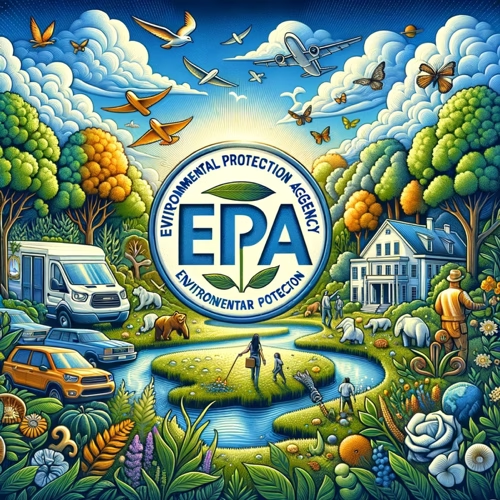Bra podd
Sveriges mest populära poddar

Environmental Protection Agency (EPA) News
EPA Overhaul and Budget Cuts: The Future of Environmental Protection in America
4 min • 30 maj 2025
The Environmental Protection Agency’s biggest headline this week is a sweeping reorganization designed to better integrate science while fundamentally reshaping how the agency delivers clean air, land, and water across America. Administrator Lee Zeldin just announced the creation of the new Office of State Air Partnerships under the Office of Air and Radiation, a move aimed at streamlining collaboration with state, local, and tribal air permitting agencies. Zeldin says, “This collaborative strategy will address permitting issues more effectively and ensure that the EPA collaborates with states to advance our mutual objectives.” The agency is also standing up the Office of Clean Air Programs for greater transparency in regulatory development, and elevating priorities like emergency response and water reuse in its Office of Water.
But headlines are also dominated by the proposed 55% cut to the EPA’s annual budget—down by $5 billion—which would lead to the largest reduction in agency history. Such cuts could mean mass layoffs, diminished enforcement of air and water quality standards, and curtailed environmental justice initiatives. Advocacy groups warn about the risks, with one environmental leader remarking, “When the next toxic disaster strikes, who will answer the phone and respond?”
Organizational changes are significant too. EPA is consolidating staff and shifting resources to reduce costs and address longstanding backlogs, notably speeding up the review of over 500 new chemicals and more than 12,000 pesticide evaluations currently delayed. “The American populace deserves an EPA that effectively reconciles environmental stewardship with economic growth,” Zeldin said.
On the policy front, EPA is advancing 31 deregulatory actions in pursuit of President Trump’s agenda, which include reassessing previously established emission limits and reporting requirements for power plants, oil and gas, and chemical facilities. These actions are expected to reduce regulatory costs by trillions and, according to the administration, lower the cost of living for families and businesses. The EPA is also working to ensure “passive receivers”—like local water utilities—aren’t unfairly burdened by PFAS contamination, while continuing efforts to hold polluters accountable.
For American citizens, these moves may mean fewer direct protections and resources at the local level, making state responses and local partnerships more essential than ever. Businesses can expect significant regulatory relief, especially in energy and manufacturing sectors, though rapid change may create uncertainty and uneven standards across states. State and local governments are being tasked with more responsibility, often with fewer federal resources. Internationally, the U.S. posture on environmental regulation is shifting, with cooperation and leadership in multilateral efforts likely to diminish.
Looking ahead, keep an eye on congressional debates over EPA funding, public comment periods for the new regulatory rollbacks, and the rollout of the Office of State Air Partnerships. Citizens can engage by reaching out to their legislators, submitting comments during public rulemaking, or joining local efforts to monitor and protect their communities.
For more information, visit epa.gov or your state’s environmental agency. And if you care about how air and water quality affect your life, now is the time to get involved—your voice and participation matter more than ever.
But headlines are also dominated by the proposed 55% cut to the EPA’s annual budget—down by $5 billion—which would lead to the largest reduction in agency history. Such cuts could mean mass layoffs, diminished enforcement of air and water quality standards, and curtailed environmental justice initiatives. Advocacy groups warn about the risks, with one environmental leader remarking, “When the next toxic disaster strikes, who will answer the phone and respond?”
Organizational changes are significant too. EPA is consolidating staff and shifting resources to reduce costs and address longstanding backlogs, notably speeding up the review of over 500 new chemicals and more than 12,000 pesticide evaluations currently delayed. “The American populace deserves an EPA that effectively reconciles environmental stewardship with economic growth,” Zeldin said.
On the policy front, EPA is advancing 31 deregulatory actions in pursuit of President Trump’s agenda, which include reassessing previously established emission limits and reporting requirements for power plants, oil and gas, and chemical facilities. These actions are expected to reduce regulatory costs by trillions and, according to the administration, lower the cost of living for families and businesses. The EPA is also working to ensure “passive receivers”—like local water utilities—aren’t unfairly burdened by PFAS contamination, while continuing efforts to hold polluters accountable.
For American citizens, these moves may mean fewer direct protections and resources at the local level, making state responses and local partnerships more essential than ever. Businesses can expect significant regulatory relief, especially in energy and manufacturing sectors, though rapid change may create uncertainty and uneven standards across states. State and local governments are being tasked with more responsibility, often with fewer federal resources. Internationally, the U.S. posture on environmental regulation is shifting, with cooperation and leadership in multilateral efforts likely to diminish.
Looking ahead, keep an eye on congressional debates over EPA funding, public comment periods for the new regulatory rollbacks, and the rollout of the Office of State Air Partnerships. Citizens can engage by reaching out to their legislators, submitting comments during public rulemaking, or joining local efforts to monitor and protect their communities.
For more information, visit epa.gov or your state’s environmental agency. And if you care about how air and water quality affect your life, now is the time to get involved—your voice and participation matter more than ever.
Senaste avsnitt
00:00 -00:00